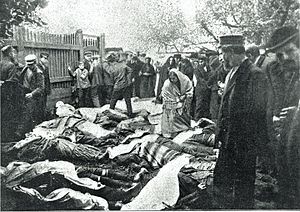User:Ostry/Sandbox10: Difference between revisions
(Created page with "{{Infobox civilian attack | title = Elsian massacres<br><small>''Rzëcniô''</small> | partof = the First Great War | image...") |
No edit summary |
||
| Line 1: | Line 1: | ||
{{Infobox civilian attack | {{Infobox civilian attack | ||
| title = Elsian massacres<br><small>''Rzëcniô''</small> | | title = Elsian massacres<br><small>''Rzëcniô''</small> | ||
| partof = the [[First Great War (Levilion)|First Great War]] | | partof = the [[First Great War (Levilion)|First Great War]] and the [[Senian Uprising]] | ||
| image = File:Pogrom_de_Bialostok.jpg | | image = File:Pogrom_de_Bialostok.jpg | ||
| image_size = | | image_size = | ||
| image_upright = | | image_upright = | ||
| alt = | | alt = | ||
| caption = The aftermath of a massacre in the | | caption = The aftermath of a massacre in the town of [[Eĺsogoŕsk]], Tyrnica, 1911 | ||
| map = | | map = | ||
| map_size = | | map_size = | ||
| map_alt = | | map_alt = | ||
| map_caption = | | map_caption = | ||
| location = | | location = [[Senia]]<br>[[Tyrnica]] | ||
| target = [[Elsians]], other {{wp|West Slavic|West Ludic}} groups | | target = [[Elsians]], other {{wp|West Slavic|West Ludic}} groups | ||
| coordinates = | | coordinates = | ||
| Line 21: | Line 21: | ||
| injuries = | | injuries = | ||
| victims = <!-- or | victim = --> | | victims = <!-- or | victim = --> | ||
| perpetrators = [[ | | perpetrators = [[Committee of National Resurgence]]<br>[[Tyrnican Armed Forces]]<br>[[Novogrodian Armed Forces]]<br>Individual groups and perpetrators | ||
| assailants = <!-- or | assailant = --> | | assailants = <!-- or | assailant = --> | ||
| weapons = | | weapons = | ||
| Line 39: | Line 39: | ||
| module = | | module = | ||
}} | }} | ||
The '''Elsian massacres''' ({{wp|Kashubian language|Elsian}}: ''Rzëcniô'', lit. 'the Slaughter'; {{wp|German language|Tyrnican}}: ''Elsisch-Massaker''; [[Senian language|Senian]]: '''', '''') were the systemic killing and dispossession of predominantly [[Elsians]] during the [[First Great War (Levilion)|First Great War]]. Organized primarily through local groups allied with the [[Tyrnican Armed Forces|Tyrnican]] | The '''Elsian massacres''' ({{wp|Kashubian language|Elsian}}: ''Rzëcniô'', lit. 'the Slaughter'; {{wp|German language|Tyrnican}}: ''Elsisch-Massaker''; [[Senian language|Senian]]: '''', '''') were the systemic killing and dispossession of predominantly [[Elsians]] during the [[First Great War (Levilion)|First Great War]]. Organized primarily through local groups allied with the [[Tyrnican Armed Forces|Tyrnican]] and [[Novogrodian Armed Forces]], as well as the Senian nationalist [[Committee of National Resurgence]], Elsian communities along the [[Els]] river valley were targeted for a variety of causes, ranging from fears of engaging with enemy forces to beliefs in ethnic cleansing and homogeneity. | ||
Initially limited to attacks in Tyrnican-administered [[Cernia]] and [[Upper Elsia]] by the Committee of National Resurgence, ethnic violence quickly spread into the rest of Senia and neighbouring [[Lower Elsia]] through individual action and mass paranoia. By 1914, an estimated 250,000–400,000 Elsians were murdered, almost half of the ethnic group's population. Although Elsians were the predominant target of the massacres, smaller groups of {{wp|Poles|Lassians}}, {{wp|Czechs|Orns}}, and [[Senians]] were also targeted, especially those that constituted multi-ethnic families and groups. Today, the massacres are defined as an {{wp|ethnic cleansing}} brought on by nationalist sentiments, desperation and fear during wartime, and oppurtunism to seize property and assets. There is a controversial debate if the actions that took place during the Elsian massacres constitute {{wp|genocide}}, with such accusations being primarily made by the Elsian community. | |||
==Causes== | |||
==Massacres== | |||
==Aftermath== | |||
==Number of victims== | |||
==Classification as genocide== | |||
==In popular culture== | |||
Revision as of 22:59, 19 May 2023
| Elsian massacres Rzëcniô | |
|---|---|
| Part of the First Great War and the Senian Uprising | |
 The aftermath of a massacre in the town of Eĺsogoŕsk, Tyrnica, 1911 | |
| Location | Senia Tyrnica |
| Date | 1909–1914 |
| Target | Elsians, other West Ludic groups |
Attack type | Massacre, ethnic cleansing, genocide (debated) |
| Deaths | 250,000–400,000 |
| Perpetrators | Committee of National Resurgence Tyrnican Armed Forces Novogrodian Armed Forces Individual groups and perpetrators |
| Motive | Anti-Elsian sentiment, Tyrnican nationalism, Senian nationalism |
The Elsian massacres (Elsian: Rzëcniô, lit. 'the Slaughter'; Tyrnican: Elsisch-Massaker; Senian: ', ') were the systemic killing and dispossession of predominantly Elsians during the First Great War. Organized primarily through local groups allied with the Tyrnican and Novogrodian Armed Forces, as well as the Senian nationalist Committee of National Resurgence, Elsian communities along the Els river valley were targeted for a variety of causes, ranging from fears of engaging with enemy forces to beliefs in ethnic cleansing and homogeneity.
Initially limited to attacks in Tyrnican-administered Cernia and Upper Elsia by the Committee of National Resurgence, ethnic violence quickly spread into the rest of Senia and neighbouring Lower Elsia through individual action and mass paranoia. By 1914, an estimated 250,000–400,000 Elsians were murdered, almost half of the ethnic group's population. Although Elsians were the predominant target of the massacres, smaller groups of Lassians, Orns, and Senians were also targeted, especially those that constituted multi-ethnic families and groups. Today, the massacres are defined as an ethnic cleansing brought on by nationalist sentiments, desperation and fear during wartime, and oppurtunism to seize property and assets. There is a controversial debate if the actions that took place during the Elsian massacres constitute genocide, with such accusations being primarily made by the Elsian community.